The WaterTribe Rudder
The Best Rudder for Kayak Sailing
By Steve Isaac (aka Chief)
I posted the criteria for the perfect WaterTribe Rudder in the discussion forum
over two years ago. Here is the original text:
| Does anyone know of a good off the shelf sailing/paddling rudder for kayaks and
canoes? I've been looking for some time now and haven't found anything I
really like. The Seaward rudders seem to be the best bet so far, and they
work OK up to about 6 knots with the wind up to and behind the beam. But
when speeds increase or trying to beat into the wind they begin to lose
it. My guess is that they need to be deeper, more rigid, and have a foil
shape. If there is nothing available off the shelf, maybe we could design one
right here in this forum. Here's a "spec" for what I'm looking for:
-
A solid stern mounting system suitable for retrofitting kayaks and canoes
-
Lightest possible weight that still has the strength, stiffness, and toughness
needed for the job
-
Roughly 1.5 sqft for a single and 2.0 sqft for a double - below
the waterline
-
A foil shape optimized for 6 to 12 knots - but an average speed of only 4 knots
-
A balanced rudder with some portion of the underwater profile forward of the
leading edge
-
Ability to raise or lower the rudder from the cockpit. Note that this
rudder does NOT need to come up over the deck like a typical kayak
rudder. It just needs to come up high enough to clear the beach
-
A hold down system for high speed sailing. Must be able to absorb shock
when the rudder hits something
-
A control mechanism that allows foot or hand control -- and self steering for
at least a few minutes at a time
-
Simplicity for repair in the field - although it should be tough enough to not
need this often
-
Plans to allow home building at a reasonable cost
|
After a very long discussion I settled on the following:
| OK, we've had lots of good input pro and con regarding rudder shape and
size. It's time to take stock and make some choices. Here is what
I'm settling on so far.
WaterTribe Sailing Rudder (for a single):
-
8" chord
-
18" below the waterline
-
NACA 0009 foil
-
Assumes a vertical mount - custom stopper for fine tuning balance
-
Balanced with 8% of the surface area forward of the pivot axis
You'll notice that this conforms with Wizard's recommendations and is about the
size of my current rudder used on my Dreamcatcher. Of course the main
difference is the foil shape and balance. My current blade has about 20%
of the underwater area ahead of the pivot point. I believe this is about
right for a flat plate, but maybe not that much is needed for a foil.
Also, I liked Wizards reasoning for having the center of pressure about 1"
behind the pivot point so the rudder will center itself. So I'm starting
with only 3/4" ahead of the pivot axis - not much.
|
So that's enough history. I asked Wizard to work with me on the
final design. He did all the hard stuff and came up with some ingenious
solutions for things like the catamaran tiller and the push/pull tiller.
Thank you Wizard (aka Matt Layden) for a job well done.
The following photo essay shows the prototype rudder I had built. After
working with the prototype we modified the design a bit so that it would work
on both standard and high volume Sea Winds and Dreamcatchers. It will
also work on other kayaks and canoes depending on the height of their stern.
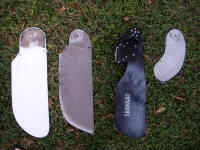
Right to Left - original Kruger blade, the Seaward Double Kayak blade, homemade
aluminum blade, the WaterTribe Rudder Blade.
|
I've tried all of these and a couple not shown. The
WaterTribe Rudder Blade is the best for sailing. The Kruger blade is the
best for paddling.
Why is it the WaterTribe blade is the best for sailing? It
has a foil shape and is much stiffer than the flat aluminum plate. The
foil shape provides lift. The composite construction reduces weight and
provides a stiffer blade which virtually eliminates vibration at high speeds
and the blade doesn't lose its bite on the water due to flexing.
|
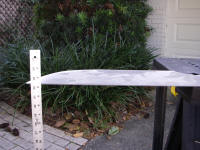
The aluminum blade with no weight.
|
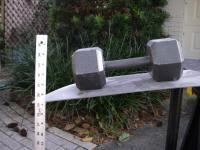
The aluminum blade weighted with a 25 pound dumbbell.
|
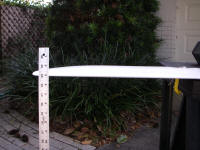
The WaterTribe Blade with no weight.
|
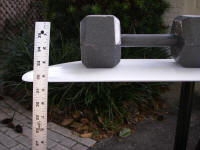
The WaterTribe Blade weighted with a 25 pound dumbbell.
|
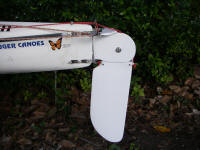
Side view of the rudder in its normal deployed position. This is the
position I use with just enough area in front of the pivot to provide positive
feel for steering.
|
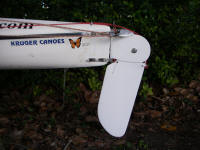 Rudder
blade when fully forward. The rudder may be balanced to your liking by
adding a rudder stop as shown in the plans.
|
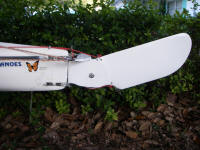
Rudder blade when fully raised.
|
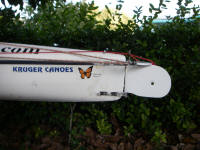
Rudder blade removed for trailering. NOTE: Never trailer the boat
with the blade installed.
|
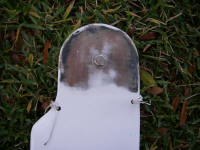
The uphaul and downhaul are attached using marine twine lashing.
|
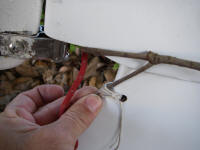
Use a screwdriver or a twig to catch all the lashing loops (6 minimum) and make
them all the same length.
|
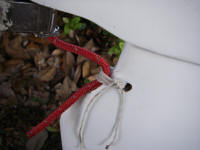
Carefully thread the downhaul line thru all the lashing loops.
|
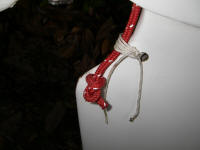
Tie a figure 8 stopper knot to the end of the downhaul line.
|
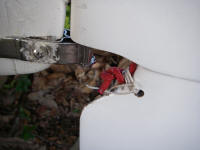
Snug up the downhaul line by attaching it to the bungee.
|
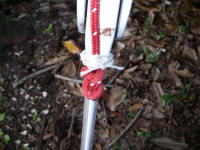
Repeat the procedure for the uphaul line.
|
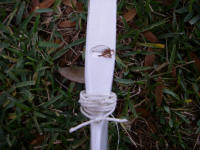
This dent is caused by the uphaul when the rudder contacts the control head in
the fully up position. The blade needs some Kevlar reinforcement in this
area. However, the "damage" will not harm the blade.
|
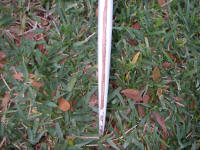
The Kevlar strip on the leading edge of the rudder can be seen after the paint
has been rubbed off by miles of dragging thru the sand and rocks of shallow
bottoms. This wear is normal.
|
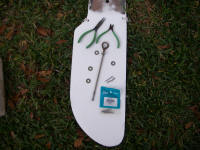
The parts needed for the pivot pin which connects the rudder control head to
the gudgeons. Note the eye at the top of the pin which is vitally
important.
|
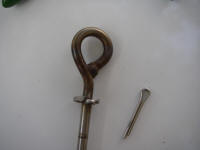
The pivot pin is held in place by clevis pins. The top pin is shown
installed and the bottom pin is shown before installation.
|
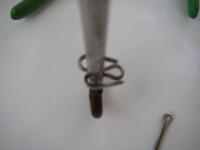
This view more clearly shows how the clevis pin should be formed so that it
remains installed.
|
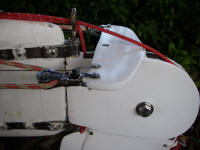
A close up view of the pivot pin installed. Note how the uphaul and
downhaul are routed thru the eye of the pivot pin.
|
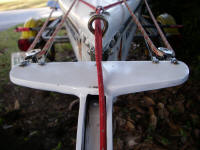
The rear view of the rudder control head mounted.
|
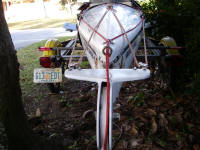
This shows the control lines leading forward: uphaul, downhaul, hand steering,
foot steering.
|
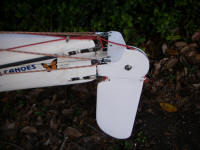
A final top view of the mounted rudder.
|
|
Three methods of steering are supported: foot pedals, hand steering line,
or push/pull tiller. I suggest rigging at least two of the three. I
use the foot controls and a hand steering line routed thru a TillerTamer.
This allows long distances of self steering as shown in the following video
clip:
Self Steering Video Clip (~50 MBytes)
The plans also provide a two piece catamaran tiller. If two Kruger Canoes
are catamaraned together and both boats have the WaterTribe Rudder with the
optional catamaran tiller installed, then the rudders can be linked such that
one person is controlling both rudders. Note that when using this option
you will require three Kruger Cat Poles. One for the forward tube, one
for the rear tube, and one for connecting the two catamaran tillers. Also
note that this configuration has not been tested yet.
Side View Showing Cat Tiller
But the rudder without the catamaran tiller has been tested under extreme
conditions. This rudder steered two Kruger Dreamcatchers in a catamaran
configuration during the 2005 Everglades Challenge. The rudder on
ManitouCruiser's boat was not used most of the time. We surfed two
Dreamcatchers at speeds of 10+ knots for an extended period with no trouble.
This rudder was also used by me on a single Dreamcatcher during the 2005 Dry
Tortugas Challenge to cross from Everglades City to Key West. The rudder
self steered for virtually the entire distance as shown in the previous video.
Plans are available for $35 plus postage. The installation kit is $100
plus postage but is subject to change depending on prices of imported
gudgeons. Buying the plans entitles you to build or have built one rudder
blade and control head. Note that rigging and other optional items are
not included in the installation kit.
Note the following links contain information that is subject to change at any
time.
Installation Kit List
Installation Instructions
WaterTribe does not warrant or guarantee the rudder in any way what so
ever. WaterTribe and all associated entities do not accept any
responsibility for any aspect of building, installing, or using the rudder and
associated components. All use is at your own risk and responsibility.
© Steve Isaac 2006
|